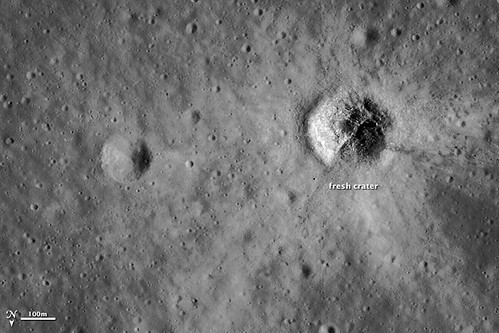Meteor Crater
- By Maggie Masetti
- August 13, 2010
- 3 Comments
Faith recently blogged about the meteor strike that killed the dinosaurs. That may have been the Big One, but the Earth has gotten hit by meteors plenty of other times.
Meteor Crater is east of Flagstaff in the Arizona desert. It’s nearly 3/4 of a mile across!
It was created 50,000 years ago by a nickel-iron meteorite about 50 meters across in size, most of which was vaporized during the course of the impact – little of the meteorite remains (though there is a chunk of it in the associated visitors center). Meteors of this size actually strike the Earth every one to two thousand years.
This crater was discovered by settlers in the 19th century and for a long time it was actually thought to be the result of a volcano. Later on, mining engineer Daniel M. Barringer theorized that it was an impact crater from a large iron meteorite – he spent 27 years looking for a large deposit of iron, not realizing that the amount he was looking for was non-existent. Barringer wasn’t investigating this purely in the interest of science, though – iron ore was worth a lot of money and the amount that Barringer was looking for was worth a billion dollars in 1903! Barringer, of course, never found that ore – and never really proved that the crater was due to an impact.
It wasn’t until 1960 that planetary scientist Eugene Shoemaker confirmed Barringer’s theory by finding a rare form of silica called stishovite in the crater. This mineral, created when quartz-bearing rocks are instantaneously and severely shocked, is indicative of only one thing. An impact. Ok, two things. An impact, or a nuclear explosion. At any rate, it completely ruled out volcanoes.
This discovery was important because it the very first time a crater had been proven to be caused by an impact from an extraterrestrial object. Since then, of course, there have been many impact craters discovered all around the world.
Because Meteor Crater (also known as Barringer Crater after the first person to correctly suggest it was formed by an impact) is in the desert, it is also exceedingly well-preserved. Visually, it is truly stunning.
The desert nearby is very flat…
…until you get to near the edge of the crater, which is where you start to see the ground rising slightly:
The visitor’s center:
Astronauts trained for Apollo missions on this crater!
This is the largest fragment of the meteorite that made the crater!
When you first round the corner of the visitor’s center, the view is breathtaking:
You can easily walk around part of the rim – and they have much longer hikes around the whole thing. Unfortunately, we didn’t have time to do this:
The initial crater was 4000 feet across, and 700 feet deep, though subsequent erosion has partially filled the crater so that now it’s only around 550 feet deep. You can actually see some of the exposed layers of limestone and sandstone beneath the rim of the crater. You can also see large stone blocks that were created by the impact.
Here’s one such large boulder, with me sitting on it. There was a pretty sheer drop behind me:
The pattern on this rock is thought to be caused by gassified iron that re-liquified into little pellets that made impressions in the rocks.
At the bottom there is a fence, some excavation equipment, and a flat 6-foot high fake astronaut and US flag for scale. You can barely see them without binoculars!
The crater is really beautiful from space too – and you can make out the visitor’s center at the top:

Image courtesy the National Map Seamless Server.
Meteor crater is relatively young at 50,000 old. A fresh crater on the Moon lasts much longer because of the lack of wind and weather and vegetation. This one, located on the far side of the Moon, south of Tsander Crater, is less than 500 million years old. There are bright “rays” around it, showing that the impact is fresh. Over time the material ejected by the impact darkens. Boulders and lunar dust also litter the crater floor.

Image courtesy of Earth Observatory and Lunar Reconnaissance Orbiter Camera.
















[…] past day include this one on the meteor man Alexander Stewart Herschel by the Science Museum and this one on Meteor Crater by NASA Goddard’s Blueshift […]
The wonders of nature are so amazing… let’s just hope that the next big one will be something we see and not something we feel !-)
Agreed!!